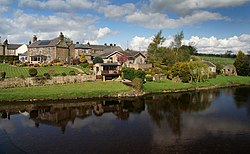Wark on Tyne: Difference between revisions
Created page with "{{Infobox town |name=Wark |county=Northumberland |picture=Wark - geograph.org.uk - 1272816.jpg |picture caption=Housing on the banks of the River North Tyne at Wark |os grid r..." |
|||
| Line 42: | Line 42: | ||
{{Commons}} | {{Commons}} | ||
*[http://www.northofthetyne.co.uk/WarkTyneCastle.html Images and History of Wark Castle site] | *[http://www.northofthetyne.co.uk/WarkTyneCastle.html Images and History of Wark Castle site] | ||
*{{genuki|Wark} | *{{genuki|Wark}} | ||
*[http://communities.northumberland.gov.uk/Wark-on-Tyne.htm Northumberland Communities: Wark-on-Tyne] | *[http://communities.northumberland.gov.uk/Wark-on-Tyne.htm Northumberland Communities: Wark-on-Tyne] | ||
==References== | ==References== | ||
{{reflist}} | {{reflist}} | ||
Revision as of 07:14, 20 November 2015
| Wark | |
| Northumberland | |
|---|---|
 Housing on the banks of the River North Tyne at Wark | |
| Location | |
| Grid reference: | NY865775 |
| Location: | 55°5’30"N, 2°12’47"W |
| Data | |
| Population: | 741 (2011) |
| Post town: | Hexham |
| Postcode: | NE48 |
| Dialling code: | 01434 |
| Local Government | |
| Council: | Northumberland |
| Parliamentary constituency: |
Hexham |
Wark on Tyne, usually just called Wark, is a small village on the North Tyne in Northumberland about twelve miles north of Hexham.
The name is derived from the Old English word for earthworks, and refers to the mound at the south of the village, where a meeting hall once stood. The hotel name 'battlesteads' is taken from the stables that once stood there.
History
Though a small village now, Wark was once of some importance – here stood a castle, Wark in Tyndale Castle and in the Middle Ages the town, which it could call itself, was the capital town of the Lordship of Tynedale. Even today it has a 'Town Hall', rather than a 'Village Hall'.
In the 13th century, Scottish Kings held court in Wark. In the 15th and 16th centuries the Lordship of Wark was held by the Crown, but in 1604 King James I granted it to James Elphinstone Lord Balmerino. In the early 17th century the Lordship was sold and inherited by the Earls of Suffolk and eventually came to be owned by the Duke of Northumberland.
The Trade Directory of 1887 shows Wark as a thriving community with a full range of trades and profession was represented: butchers, shopkeepers and a miller but also a rabbit catcher, trap proprietor and a confectioner.
Over the 19th century the village has maintained a modest number of residents. In 1801 it was 304 and by 1851 this had slightly risen to 483, while in 1881 the total number of residents stood at 513.
The River North Tyne between Wark and Chollerton was originally crossed by a wooden bridge supported on eight stone pillars. In the 1870s the wood was removed and replaced by an all iron structure.
Parish church
The church of St Michael is a fine, Victorian Gothic edifice with a crenelated tower. It was built between 1814 and 1818 by the Governors of Greenwich Hospital and together with the Rectory cost over £7,000 to construct.
From the late nineteenth century, Wark also had a Presbyterian Church and Manse built in 1875, and a Wesleyan Chapel.
Transport
Wark was served by Wark railway station on the Border Counties Railway, the first section of which opened between Hexham and Chollerford in 1858 and the remainder in 1862. The line was closed to passengers by British Rail in 1956. Part of the line is now beneath the surface of Kielder Water.
Outside links
| ("Wikimedia Commons" has material about Wark on Tyne) |
- Images and History of Wark Castle site
- Information on Wark on Tyne from GENUKI
- Northumberland Communities: Wark-on-Tyne
